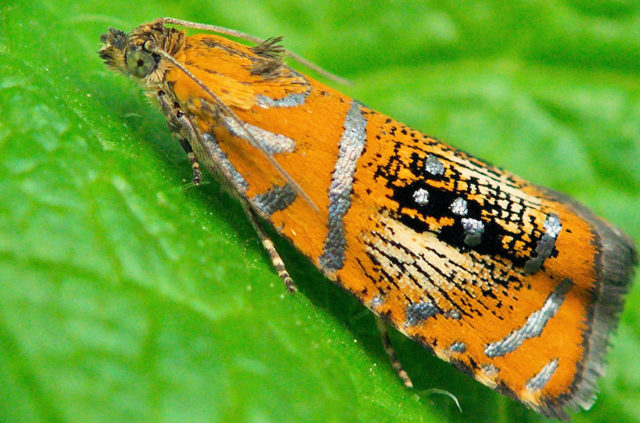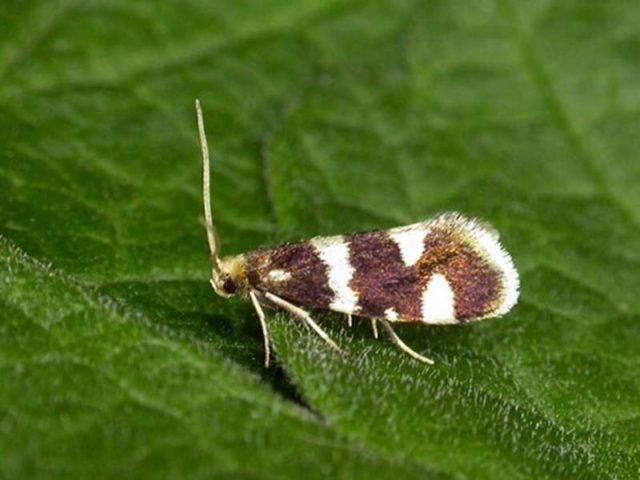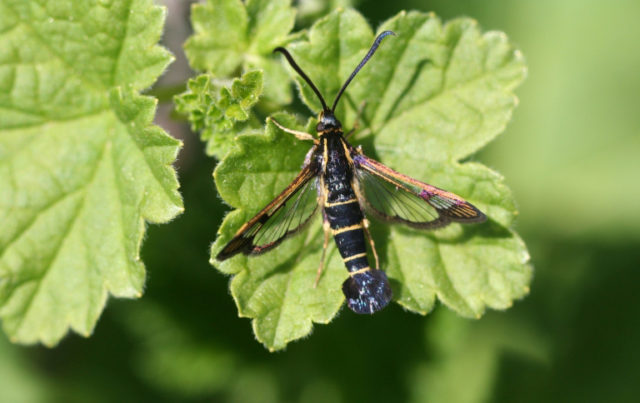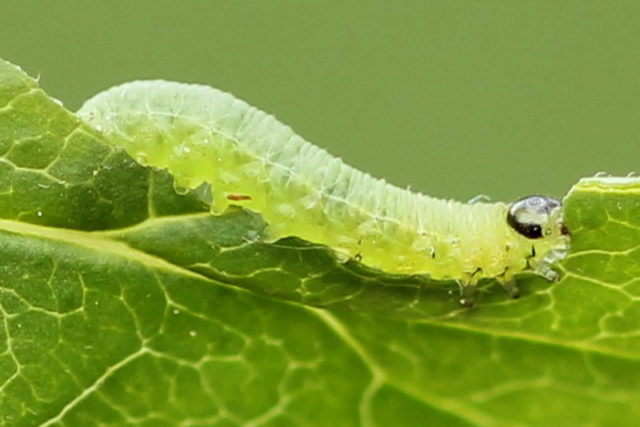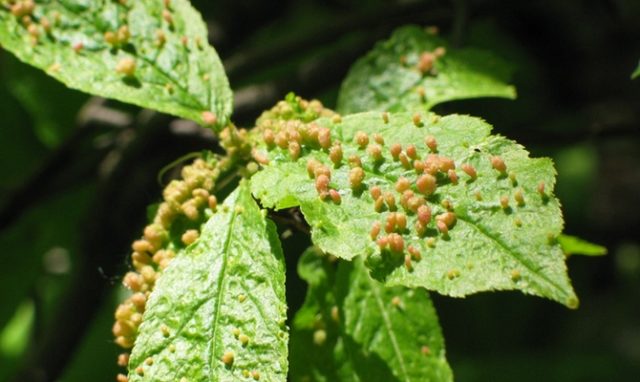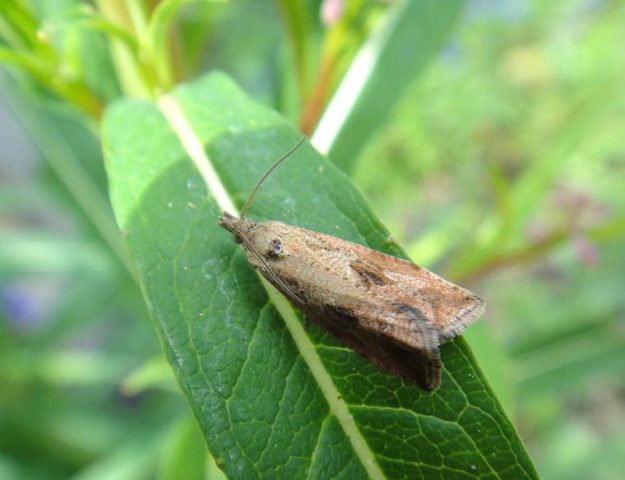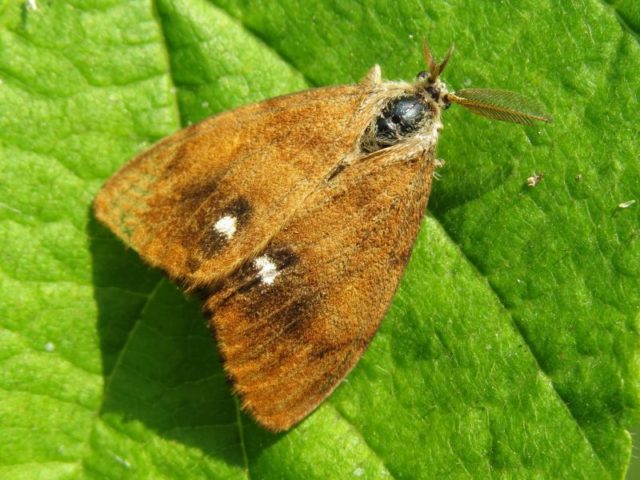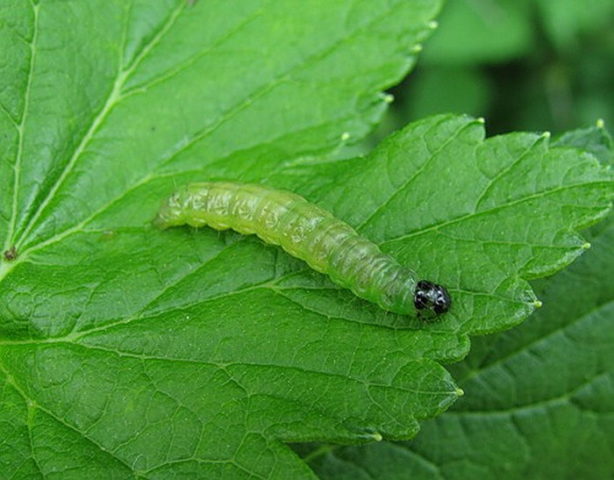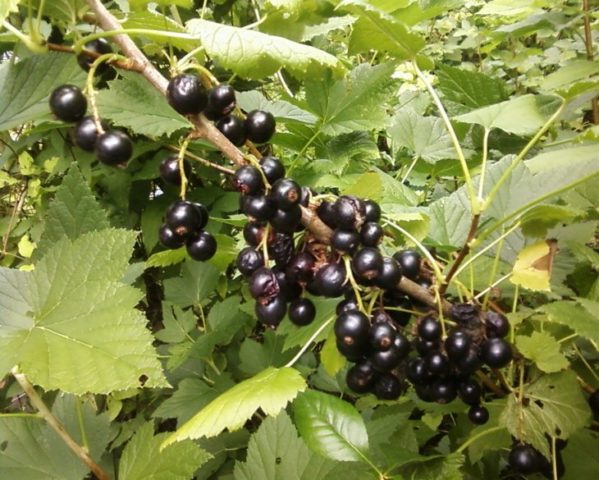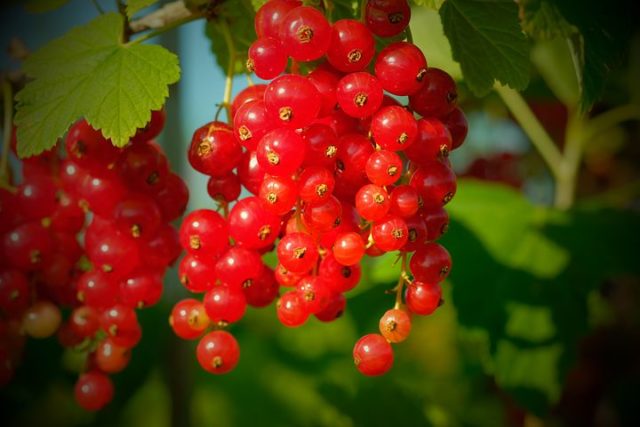Content
Caterpillars on currants completely eat up the leaves - many gardeners face such a problem. Parasites on the stems and leaves of a plant can completely destroy the crop, but there are many methods of currant pest control.
Types of currant caterpillars
First of all, you need to understand that there are a lot of currant pests - caterpillars can appear when a bush is affected by a variety of insects. It is useful to know the main varieties of garden pests - this will help to recognize which caterpillars have affected the shrub, and to choose the most suitable treatment tool.
Leaf roll
This pest can be recognized by the appearance of green or brown caterpillars on the leaves of the bush, first they actively eat the foliage and stems, and then entangle the leaves with cobwebs and feed on the juices of the plant until hatching. The adult leafworm is a light brown butterfly with stripes on its wings.
Kidney moth
The parasite lays eggs in the ovaries and young buds of the bush, and the hatched larvae of gray or yellow-brown color begin to eat up the plant from the inside. This leads to the fact that part of the ovaries of the bush dries up, and the yield of the plant decreases sharply. The formed kidney moth is a small insect about 1.5-2 cm in wingspan with a rather beautiful white-brown coloration.
Moth
The large yellow butterfly lays eggs in early spring on the inside of currant leaves, mostly white and red. The moth larvae completely eat away the leaves of the plant and can lead to the complete death of the currant bush, if they are not eliminated in time.
Glass-maker
An adult insect, outwardly similar to a wasp, arranges clutches in the buds of a currant or in the folds of the bark on its trunk. The caterpillars hatched from the larvae first eat the shoots from the inside, and then begin to move along the stems to the roots. It is precisely with this that the glass pot is dangerous, if the caterpillars eat the roots of the bush, then it will no longer be possible to save the plant from death. At the same time, the glass case lends itself extremely poorly to removal, and considerable efforts have to be made to eliminate it.
Sawfly
Small black beetles lay their eggs on the leaves of the bush, and the caterpillars eat up the foliage right down to the veins; if the sawfly breeds heavily on the bush, the currants may remain completely naked. At the same time, a sawfly can give up to 3 broods of caterpillars in one summer, which greatly complicates the fight against the pest.
Gallica
The parasite, which looks like a mosquito, in the caterpillar phase eats mainly the tissues of currant stems, as a result of which black swellings appear under the bark. Mostly gall midge prefers to feast on black currant, however, the parasite can be found on both red and white varieties.
Gooseberry moth
The parasite is a gray butterfly attacking currant flowers, as well as raspberry and gooseberry bushes. The moth caterpillars entangle the fruits of the berry bush with a thin web and draw out juices from them, as a result the berries dry out and become unsuitable for harvesting.
Brushtail
Often, a stinging caterpillar, or a tassel, another pest butterfly with a beautiful reddish-brown color, starts up in the currant. The caterpillar feeds on the leaves of the plant and is especially dangerous for the reason that it lays up to 400 eggs at a time - infection of currants with a stinging bird can occur very quickly and abundantly.
Why caterpillars start in currants
The buds, leaves, fruits and all other parts of the currant are a breeding ground for caterpillars - pests eat the leaves to continue their life cycle. However, this does not clarify the question of why parasites grow very often on some bushes, while others are almost never affected by caterpillars.
As a rule, caterpillars start on the bushes of the fruit plant if the rules for caring for the shrub are not followed. If the gardener neglects regular sanitary pruning of bushes, does not remove broken and dried branches and does not remove plant debris from the soil at the roots, then sooner or later pests may take a fancy to the shrub. Fallen foliage and small twigs near currant bushes provide the larvae of caterpillars with a winter shelter - the pests safely wait out frosts in the ground, and in the spring they move to the currant bush and begin to feed on fresh greens.
Why are caterpillars dangerous for currants?
The presence of caterpillars on currant bushes not only impairs the appearance and decorative effect of the bush. This becomes the least of the problems.
- Spawned caterpillars can completely eat currant foliage. Most pests begin to feed on the plant from the leaves, which contain a huge amount of nutrients. If the parasites are not eliminated in time, the currants may be eaten whole.
- Caterpillars eat not only green foliage, but also inflorescences, ovaries and rudiments of bush berries. Thus, with a widespread defeat of the shrub, the currant either begins to bloom and bear fruit worse, or stops yielding - the parasites destroy the fruits before they reach full maturity and become suitable for harvest.
- Caterpillars feed on the stems and even the roots of the bush. This is especially dangerous, since the very skeleton of the plant is destroyed - if the pests are not destroyed in time, then the shrub can die entirely, since it will be left without a root system and main shoots.
Currants infected with pests cease to produce a sufficient amount of tasty healthy berries. Its varietal characteristics deteriorate significantly - the shrub becomes more sensitive to growing conditions and vulnerable, stops developing and eventually dies.
What to do with currant caterpillars
If caterpillars of this or that pest have started up on the currant bushes, they definitely need to be removed. In gardening, both folk methods and specialized means are used for this.
Mechanical methods of struggle
The most obvious and easiest way to combat currant caterpillars is to mechanically remove insects. The following methods are practiced:
- shaking off - paper or light dense fabric is spread under the currant bush, and then they take the branches and shake them properly, as a result of which the caterpillars simply crumble from the leaves onto the prepared litter;
- manual collection - leaves and stems of currants are regularly examined and the caterpillars and pests' nests are removed from them by hand, in order to then take them out of the site and destroy;
- fromscraping - if the trunk and shoots of currants are damaged, caterpillars and larvae can be removed with a hard-bristled toothbrush or even a metal sponge dipped in soapy water.
For all its simplicity, mechanical methods have a serious drawback. They do not give one hundred percent efficiency; in such a way it is impossible to remove absolutely all caterpillars and larvae from the currant bush. Meanwhile, even a few parasites remaining on the bush continue to negatively affect the state of the plant, and over time they again increase the population.
Chemicals
A more noticeable and qualitative effect against caterpillars is provided by proven chemical preparations. Namely:
- Karbofos 10% - it is used against kidney moths twice a summer, for the first time it is necessary to apply the agent after the buds open on the bush;
- Karbofos 0.3% - the currants are processed from the moth, spraying is carried out in April, during the active development of the buds, and in June, when the butterflies of the garden pest hatch;
- Iskra-Bio and Fufanon - currants are sprayed with solutions against the sawfly and moths, the procedure is carried out before the flowering of the bush and immediately after it;
- Fitoverm - the agent is sprayed on the currants immediately after the appearance of fresh leaves, this helps to prevent infection of the shrub with glass.
Also, a 10% solution of Karbofos can be sprayed with currant bushes from the glass caterpillar, they usually do this in the fall, after harvesting for preventive purposes.
Biological preparations
In addition to chemical insecticides, biological products are in demand among gardeners. The difference is that the active ingredients in biological products are toxic to caterpillars, but do not harm the currant fruit and do not affect the benefits of berries. The effect is achieved due to the fact that the attack on pests is carried out by viruses and pathogenic fungi that are detrimental to garden caterpillars.
Biologicals include:
- Lepidocide and Nembact;
- Endobacterin;
- Bitoxibacillin.
Traditional methods
Some gardeners are afraid to treat currants from caterpillars with insecticidal preparations and prefer to use folk remedies. Among the most popular are the following.
- Laundry soap solution. A bar of natural soap with a volume of about 50 g must be dissolved in 1 liter of water until a homogeneous soap solution is obtained. After that, the bush is sprayed with soapy water, and if necessary, the leaves, which are especially affected, are manually wiped.
- Mustard. About 50 g of powder must be diluted in 3 liters of water, and then spray the currant bush with the resulting solution. Mustard has a detrimental effect on insect caterpillars and allows you to quickly get rid of pests on leaves and stems.
- Garlic infusion. Several large cloves of fresh garlic need to be poured with 1 liter of water and insisted for a week, closed. When the infusion is ready, before use, it will need to be diluted with fresh water in a ratio of 1 to 10. Otherwise, the spicy infusion can not only eliminate the caterpillars, but also harm the currants, since it will leave burns on the leaves and stems of the plant.
- Pepper infusion. The folk remedy acts similarly to the garlic tincture and is prepared in about the same way - 100 g of hot pepper is poured into 1 liter of boiling water and insisted for several days. Before use, the infusion can be diluted in a ratio of 1 to 10 with ordinary clean water, or you can prefer a soapy solution, in which case the effectiveness will only increase.
Folk remedies bring a fairly good effect in the fight against the caterpillars of garden pests. However, they may not act as quickly as insecticides and biologicals, it is likely that several treatments will have to be carried out for a heavily affected currant bush.
Preventive actions
If caterpillars on currant bushes are noticed in a timely manner, then getting rid of them is quite easy. But it is even better, in principle, to prevent the appearance of pests on the fruit shrub. Preventive measures help protect the plant from caterpillars.
- Currant bushes must be trimmed regularly. Sanitary pruning allows you to get rid of dry and diseased branches, from excess shoots that thicken the bush, from broken branches. Statistics show that unkempt currants are affected by garden pests much more often, and it is much more difficult to cure such a shrub.
- It is necessary to carefully monitor the cleanliness of the soil around the plantings of currants. Every spring and autumn, all fallen leaves and broken branches from the ground must be removed so that they do not form an ideal winter shelter for pest larvae.
- In the fall, the soil around the currants must be dug up, in the process adding wood ash or tobacco powder to it, these funds interfere with the life of the larvae and do not allow them to develop. It is also recommended to mulch the soil around the shrub in the fall with a layer of 5-10 cm, in which case it will be more difficult for the caterpillars to get to the soil surface and switch to currants in the spring.
- For prophylaxis, it is recommended to plant plants such as garlic, yarrow, wormwood and chamomile next to currant bushes, as well as other herbs with medicinal properties and a pungent odor. Such neighbors of currants will scare off harmful insects with their aroma and protect the shrub from being damaged by caterpillars.
Even if the currant has never been sick or affected by garden pests for several years of cultivation, every year its leaves and stems should be examined for nests and insect larvae. Caterpillars noticed quickly are much easier to remove with both folk and specialized means.
Conclusion
Caterpillars on currants completely eat up the leaves, however, harmful insects can be quickly removed at once in several effective ways. The main thing is not to forget about prevention and often inspect the shrub so as not to miss the moment when harmful caterpillars appear on the leaves.
